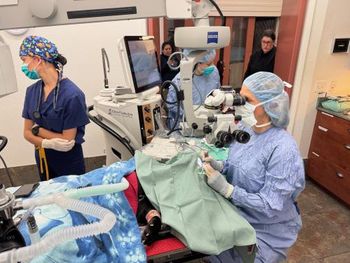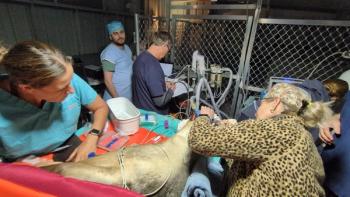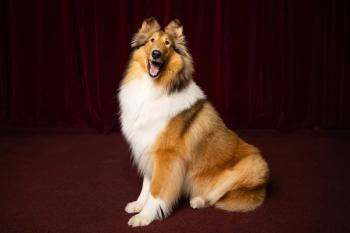
How to make the most of your ophthalmic examination (Proceedings)
Advice on how to perform an organized examination of the eye.
Objectives
• How to perform an organized exam
• Diagnostic procedures
o STT
o Culture, cytology
o Staining
o Tonometry
• Direct and indirect ophthalmoscopy
So, where to start...?
• Thorough history
• Signalment
• Primary complaint
• Current treatment if any
• Concurrent disease, attitude, appetite, etc.
• Travel history
Observation from a Distance
• Watch the patient enter the exam room and move about obstacles in the room
• If vision loss is suggested by history, consider maze/obstacle course testing in both light and dim/dark conditions
• Evaluate the face for symmetry and note any signs of lameness, which may relate to underlying systemic disease
Restraint
• Small animals can generally be manually restrained either in a corner or on a table
• Muzzles and towels can be used with fractious patients
• Equine patients usually require sedation and local nerve blocks
• Cattle can be examined in a head chute
• Exotics can be held or sedated
Beginning the Exam
• Observe the face and eyes for symmetry, evaluate palpebral reflex, menace response, retropulse the globes and palpate the orbits
• Evaluate pupils in light and dark, perform PLrs, swinging flashlight test, and dazzle
• Get an overall picture of the lids, cornea and conjunctiva to decide on diagnostics
Initial Diagnostics – STT
• Perform Schirmer Tear Test first
• STT1
• Measures basal, residual, and reflex tears
• Strip is placed in the ventral conjunctival fornix for one minute
• Dog (19.8 ± 5.3 mm/min), Cat (16.9 ± 5.7), Horse and cow (>15), Rabbit (5.3 ± 2.9)
Culture and Cytology
• If indicated, culture and/or cytologly of the cornea or conjunctive should be performed next, before adding any drops to the eye
• Most topical ophthalmic preparations contain preservatives that may inhibit bacterial growth, thereby affecting cultures
• Cultures can be obtainined with moistened swabs, and cytology with a swab, spatula, cytobrush, or scalpel blade (blunt end)
Vital Stains
• Sodium Flourescein
o Absorption spectrum peaks at 490nm (blue light)
o Flourescence at 520nm (green light)
o Used to detect corneal and conjunctival epithelial defects, preocular tear film deficiencies 9TFBT), NL duct patency (Jones test), leakage of aqueous from corneal wounds (Seidel test)
• Rose Bengal
o Used to detect preocular tear film disorders, mucin preocular film deficiencies, superficial corneal epithelial abnormalities
Topical Anesthetic
• Proparacaine 0.5% is most common
o Onset is from 0.25-2.0 seconds
o Duration is from 10-15 minutes
o Side Effects
• Epithelial damage and delayed wound healing
• Decreased tear formation
• Ca have antimicrobial preservatives, apply only after C/S samples have been collected
Tonometry
• The measure of IOP
• Allows evaluation of intraocular hyper or hypotension, and monitoring glaucomatous eyes for progression or response to treatment
• Direct tonometry with manometer impractical, indirect tonometery uses corneal tension to estimate IOP
• Types of indirect tonometry:digital palpatation, indentation (Schiotz), applanation (tonopen, and rebound (Tonovet)
Indentation tonometry-Schiotz
• Instrument consists of a convex corneal footplate, a 3mm diameter, jewel-mounted plunger, a holding bracket, a recording scale, and various weight options
• The low-friction plunger protrudes from the concave surface of the footplate, and each 0.05mm of plunger depression moves the style one scale unit
• Patient positioned in dorsal recumbency is best
• Footplate placed on anesthetized cornea, plunger assembly indents the cornea
• Weights are added as needed to get a scale reading of 4-8 (most accurate)
• IOP estimated for each weight and scale reading with a conversion table
Sources of Error
1. Plunger/sleeve friction or cornea.plunger riction
2. Steeper or thicker cornea-false increase
3. Footplate designed for human corneal curvature. Large eyes with flatter corneas tend to give falsely low readings
4. Small eye with greater curvature falsely increases IOP
5. Anterior corneal disease
6. Improper patient positioning
Applanation Tonometry
• The principle of applanation tonometry is that the force required to flatten a given area of a sphere is equal to the pressure within the sphere (Imbert-Fick law, P=f/a)
• Most frequently used instrument include MacKay, TonoPen and pneumatonograph tonometers
Applantation Tonometry-Tonopen
• Estimates IOP by measuring force required to flatten a constant area of the corneal surface
• Footplate is 3.22mm in diameter
• Recoil of ceramic plunger following conreal contact produces a signal that is amplified, digitized and passed thru a single microchip processor
Sources of Error
• Tension from retraction of lids
• Pressure around the neck from restraint or tight collar
• Variable thickness corneas (corneal edema?)
• Methylcellulose increased average IOP by 27% (inc. surface tension) (source?)
Direct Ophthalmoscopy – Technique
• Examining the eye by looking directly into the eye
• Performed with ophthalmoscope
• Examine patient OD with your OD, holding the lids and head with left hand
• Vice versa for OS
• Variable distance exam
o Set scope at 0 diopters move in and out
• Fixed distance exam
o Set scope at diopters and stand 2" from patient, rotate lens towards 0 to focus on deeper structures
Direct Fundic Exam
• Start 1.5-2" away at 0 d setting
• Rotate wheel toward negative 9red) until fundus near disk is visible (-2to-4D)
• Examine fundus in quadrants
• Re-focus to evaluate optic disk
• Usually within 1D of fundus, more neg. means disk depression, more positive is elevation
• Advantages: simple, inexpensive instrument, upright image, greater magnification, depth and height can be determined with diopter setting
Indirect Ophthalmoscopy
• Using a lens and light source to view a projected image of fundus
• Lenses of varying dioptic strength can be used
• Smaller diopter rating=greater magnification
• Light source can be from trans-illuminator held near examiner's eye or from binocular indirect system
• Image is inverted with R-L reversal or "upside down and backwards"
Gonioscopy
• The examination of the iridocroneal angle an ciliary cleft
• Cannot be directly visualized in most animals because of scleral shelf
• Goniolenses have been developed to bend the angle of incidence of light to less than 49° (critical angle) to see around the scleral shelf
• Viscous solutions like methylcellulose will couple the lens to the cornea for better visualization
Windows to the Soul: Feline Ocular Manifestations of Systemic Disease
The eyes are the windows to the soul: nowhere is this more true than in the discussion of feline ocular manifestations of systemic disease. Ocular clinical signs are often the earliest, and sometimes the only, clinical signs associated with certain systemic disease in cats. This lecture will comprise a summary of the more common systemic diseases that may manifest as ocular diseases. Infectious diseases, including Feline Leukemia Virus, Feline Immunodeficiency Virus, Feline Infectous Peritonities, Feline Hepesvirus, Chlamydia, Calicivirus, Mycoplasma, Systemic fungal Diseases, and Toxoplasmosis can all reveal themselves through ocular signs. Ocular examination should be a thorough part of any physical examination and knowing the ocular manifestations of systemic diseases may help enhance your diagnostic abilities.
Eye ER: Ophthalmic Emergencies
Diagnostic Equipment
• Well-lit room; dark room
• Strong focal light source and magnification
• Direct ophthalmoscope
• Indirect lens and focal light source
• Schirmer tear strips
• Flourescein Stain
• Schiotz tonometer, tonopen XL, Tonovet
• Topical anesthesia
A Good Eye exam
• Be systematic
• Look at patient before you touch
• Look for asymmetry
• Check for menace response
• Evaluate palpebral and dazzle reflex
• Evaluate direct/consensual PLR's
• Eyelids, conjunctive, third eyelid
• Cornea, sclera
• Anterior segment/posterior segment
The Red Cloudy Eye
• Many eye problems present like this....
• Three Simple tests (performed bilaterailly) and a good exam can help to differentiate diseases and make a correct diagnosis
o 1. Schirmer Tear Test
o 2. Fluorescein Stain
o 3. Tonometry
The following ocular emergencies will be discussed
• Eyelid Lacerations
• Corneal emergencies
o Full thickness laceration
o Descemetocolo; perforation
o Melting ulcers
• Intaocular emergencies
o Glaucoma (previously discussed)
o Anterior lens luxation
• Proptosis
Newsletter
From exam room tips to practice management insights, get trusted veterinary news delivered straight to your inbox—subscribe to dvm360.






